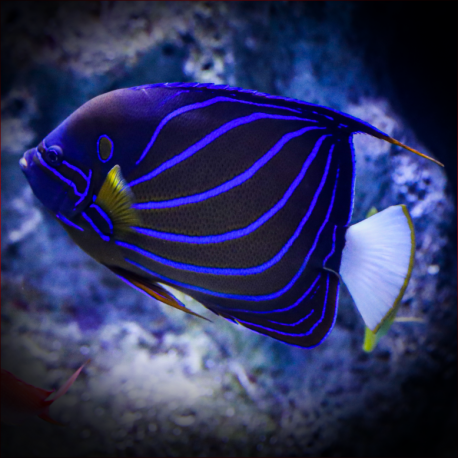More info
Datasheet
| Minimum Tank Size | 800 litres / 211.34 US gallons |
| Maximum Size | 45.0cm / 17.72inches |
| Reef Compatible | Not reef safe |
| Temperament | Aggressive towards other species |
| Temperature | 22.2°C / 71.96°F - 25.6°C / 78.08°F |
| Specific Gravity | 1.020-1.025 |
| Carbonate Hardness | 8-12 |
| pH | 8.1-8.4 |
General Description
The Bluering angelfish, scientifically known as Pomacanthus annularis, belongs to the Pomacanthidae family, renowned for their vibrant colors and striking patterns. These angelfish predominantly feed on sponges but also on soft corals, tunicates, and macroalgae in their natural habitat. Notably, there is a notable contrast in appearance between juvenile and adult Bluering angelfish, with adults growing large when adequately nourished. In captivity, it might take over a week for these fish to acclimate to feeding due to being unaccustomed to catching their own food in the aquarium.
Aquarium Suitability
Though the Bluering angelfish is considered suitable for aquariums, caution is advised. This species can exhibit aggressive behavior towards other fish, particularly peaceful or docile species. To mitigate aggression, it is recommended to provide regular feeding, ample hiding spots, and sufficient space within the aquarium.
Demands, Care, and Hardiness
The Bluering angelfish requires a high water quality to thrive, emphasizing the importance of well-oxygenated water. With an average hardiness level, this species needs a varied diet, including algae-based foods like nori seaweed and spirulina. Additionally, it's crucial to note that Bluering angelfish are not reef-safe due to their feeding habits, although selective coral choices can enable cohabitation.
Reef Suitability
Regrettably, Bluering angelfish are not deemed reef-compatible due to their tendency to feed on soft corals and LPS (Large Polyp Stony Corals). However, strategic coral selections, such as Hammer corals, Bubble corals, Star polyps, and Disc anemones, may decrease the likelihood of them being consumed.
Aquarium Setup
To cater to the Bluering angelfish's needs, it is imperative to set up the aquarium with ample hiding places, such as live rocks, to provide security for this initially shy species. Additionally, a well-established aquarium with algae-covered surfaces is beneficial as Bluering angelfish enjoy grazing on algae-rich rocks.
Behaviour
Bluering angelfish can exhibit aggressive behaviors towards other species, making it essential to introduce them last in a tank with shyer inhabitants. This species can also produce grunting sounds as a response to perceived threats.
Feeding and Diet
Feeding Bluering angelfish several times a day is recommended, especially after their introduction into the aquarium. Offering a varied diet that includes live food and algae-rich sources is crucial for their well-being.
Dimorphism and Captive Reproduction
Bluering angelfish are hermaphroditic, capable of changing gender from female to male as needed. Additionally, they tend to form pairs when introduced simultaneously.
Habitat and Distribution
Naturally found in the Indo-West Pacific region, Bluering angelfish inhabit areas ranging from the east coast of Africa to locations such as Indonesia, New Guinea, and New Caledonia, extending north to southern Japan.

